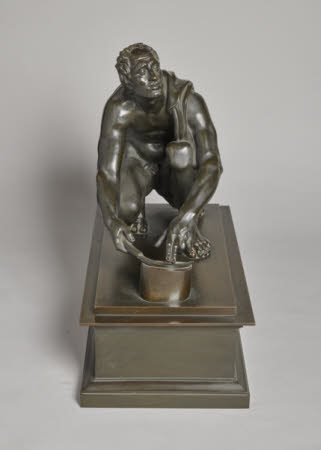The Arrotino (the knife-grinder)
French
Category
Art / Sculpture
Date
c. 1800 - 1820
Materials
Bronze
Measurements
495 x 254 mm; 464 mm (L)
Place of origin
Paris
Order this imageCollection
The Argory, County Armagh
NT 565235
Summary
Sculpture, bronze; the Arrotino (Knife-grinder); French, Paris; c. 1800-1820. A small bronze reduction of a famous antique statue which since the 1680s has been displayed in the Tribuna of the Uffizi in Florence. The figure is a follower of the god Apollo, sharpening a blade so that Apollo can flay the faun Marsyas, who defeated Apollo in a musical contest. This bronze cast was probably made not in Florence but in Paris, where the model was well-known from the late seventeenth century, since a full-size copy in marble was made for King Louis XIV of France by the Florentine sculptor Giovan Battista Foggini in 1684, for the gardens at Versailles. Bronze reductions began to be made in France already from around 1700.
Full description
A bronze reduction of the antique marble statue known as the Arrotino, depicting a crouching man, moustachioed and naked except for a piece of drapery over his left shoulder, looking upwards to his left. With his right hand he holds a small scythe on a whetting stone, holding the blade firm with the fingers of his left hand. The separately cast figure is mounted onto a substantial rectangular bronze base. The sculpture on which this bronze is based was long one of the most admired ancient sculptures and one of the highlights of the displays in the Tribuna of the Uffizi in Florence (Haskell and Penny 1981, no. 11). Generally considered to be a Hellenistic sculpture dating from the 2nd century B.C., the sculpture was first recorded in a Roman collection in the 1530s. It was acquired by the Medici in 1578 and was at first kept at the Villa Medici in Rome, before being sent along with other sculptures to Florence in 1677. By 1688 it was on display in the Tribuna of the Uffizi, alongside other admired works including the Venus de’Medici and the Dancing Faun, reductions of both of which are also at the Argory (NT 565229 and 565223). Already in 1684 the Florentine sculptor Giovan Battista Foggini (1652-1725) made a full-size copy to be sent to King Louis XIV of France for display in the gardens at Versailles (now Musée du Louvre, Paris), from which a full-size bronze was cast in 1688 by the royal bronze founder Balthazar Keller (1638-1702), now at Versailles. This meant that the sculpture was hardly less well-known in France than in Italy. Small bronze reductions were made from an early date in Paris, often paired with a figure of the crouching Venus after a marble by Antoine Coysevox (1640-1720). A very fine pair of casts from the early eighteenth century are in the Wallace Collection (Invs. S188-189; Wenley 2002, pp. 42-45). Small bronze reductions were of course also made in Italy, for example in the Roman workshops of Giovanni Zoffoli (c. 1745-1805). The sculpture has had various names over the course of time, including ‘il rotatore’ and the ‘Scythian slave’, but the one most often used is the ‘knife-grinder’ or 'Arrotino'. The precise identity of the man whetting his scythe has long been debated. In the seventeenth century one of the most popular theories was that he represented a servant or slave who is shown overhearing, whilst at his work, a conspiracy being discussed. But it was quite early demonstrated that the sculpture would in fact originally have been part of a group depicting the gruesome punishment of the faun Marsyas, who had defeated Apollo in a musical composition and was then flayed alive by the god, the Arrotino depciting one of Apollo’s followers, sharpening a knife for the god to use. The cast at the Argory is very likely to have been made in a French foundry in Paris, rather than in a Florentine workshop, so would have been modelled on the copies by Foggini or Keller or one of the earlier French bronze reductions. It has a finish that is similar to the bronze group of Belisarius by Antoine-Denis Chaudet at the Argory (NT 565234), and may well have been bought at the same time and have even been made in the same foundry. Both bronzes could well have been part of the group of ‘Five bronze figures’ valued at a total of £45 16s. 8d. that were sent from Bordeaux to Walter McGeough in November 1822. One of the main sculptor-founders in early nineteenth-century Paris was Pierre-François Feuchère (1737-1823), after whose death in 1823 a series of sales were held of items from the company’s stock, as well as sculptures collected by the older Feuchère. The sale held from 29 November 1824 included (lot 58) a bronze of the Arrotino paired with the crouching Venus, described as ‘sculpted by M. Roguier, models produced within the Feuchère factory’ (‘sculptés par M. Roguier, modèles de la fabrique Feuchère’). The Argory figure is certainly not simply a straight copy of the early eighteenth-century French casts, in which the knife-grinder perches on a small rocky support, the shape of the whetting stone is quite different and the drapery is much less schematic. There is another early nineteenth-century cast in the Royal Collection, bought for the Prince Regent in 1819 ( RCIN 35440). It shows the man seated on a support but has a similarly large and quite high base. Jeremy Warren October 2022
Provenance
Probably acquired by Walter McGeough Bond (1790-1866), c. 1822; by descent to Walter McGeough Bond (1908-86), by whom given to the National Trust in 1979.
Makers and roles
French , sculptor
References
Haskell and Penny 1981: Francis Haskell and Nicholas Penny, Taste and the Antique, The Lure of Classical Sculpture 1500 - 1900, New Haven and London, 1981, pp. 154-57, no. 11. Wenley 2002: Robert Wenley, French Bronzes in the Wallace Collection, London 2002, pp. 42-45.









